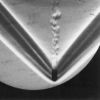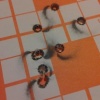The friction of the bore is one contributor. The distortion of the bullet in the bore is another. Both of these involve the bulk mass of the bullet, though, and would take some time to conduct all the way out to the bullet tip (we're talking seconds/fractions of a second, here). Actual friction with the air is probably a smaller contributor than you think; there is a lot of movement over, but a lot of convection carrying heat away at the same time, and there is a painfully small surface area in contact with the stream (and it is both behind the shockwave, and a good portion lies on the trailing side; both these factors reduce the velocity at/near the surface greatly)
One that has not been mentioned, but which I think would most directly contribute to tip melting down range, is air compression. The shockwave initiated at the tip of a supersonic body is essentially a molecular traffic jam; the momentum of the molecules won't let them shift out of eachothers' way to accommodate the body passing through, so they stack up against eachother in a denser pattern to let it through. That denser pattern is 'compression,' and it results in an increase in temperature (the 'anger' of the 'drivers' in the 'traffic jam,' if you will

). Once inside the traffic jam, everything slows down, until the disturbance (stopped car/on ramp/etc) has passed and the condensed molecules can move back to the space left behind by the bullet. You 'shock up' and then 'shock down,' as an air molecule when the bullet passes. The first is when you abruptly slam your brakes as the car in front of you does the same, and the second is when that rubber-necking idiot finally passes the car-wreck and floors it back up to cruising speed & you follow suit. After the first, you might feel very 'heated,' and much relieved after the second to be on your way once more

Since the bullet is continually stacking up a cone-shaped wave of compressed air in front of itself, that heat being generated is getting conducted straight into the mass the whole time; it's basically surrounded by a bubble of air heated up hot enough to get to sonic speed (hot air has faster 'reaction time' so the molecules can shift out of the way without generating a shock wave). The curved, smooth profiles of bullets actually result in many smaller shocks ('fan' wave shocks) all along their surface, with pressure rising along them until the taper on the back side. Now, the air cools rapidly on the tapered slope when it 'shocks down' to a lower pressure, but the tail of spritzer bullets is so short that there won't be as much heat transfer.

Darker color is denser air. Shock up (at very high pressure), pass over the body at elevated temp/pressure, shock down back to normal(ish). The more pointed the tip & faster the speed, the more triangular the shock; the faster the speed, the sharper the angle of the shock (and fiercer the pressure gradient)
The result is that the very act of the bullet ramming through the air heats it quite a lot, just by flying supersonic, and it is most pronounced at the very tip of the body; right where that polymer usually is. So I can see how this can eventually become an issue if you drive a round fast enough. Heck, when you get above Mach 5 or so, the
air & surface themselves start burning & reacting due to the heat and energy involved in these shockwaves, and above Mach 7 it's so bad the molecules begin breaking up into individual atoms & forming plasmas. By that point, things are booking fast enough that the air molecules are basically crashing into the surface to knock chunks loose (ablation) and your basically dealing with orbital re-entry type stuff.
This effect is why the Concorde had a crazy powerful air-conditioning system (I think the ambient air temp surrounding it was like 200-something degrees, if I'm remembering that college factoid correctly

. Unlike a bullet, though, aircraft also have a massive surface area for their size that really does contribute a lot of skin friction) and why the Blackbird had to be skinned in that hideously-expensive titanium (and to accommodate thermal expansion at high speed, it was made so loose it leaked fuel from joints & fasteners on the ground when cool) and why the Navy's rail gun projectiles are made of tungsten (Mach 7, yo!) and glow brilliantly in flight (and why the armature rails of the gun are turned into plasma and destroyed after only a few shots)
I wonder if
ceramic tipped bullets might be much more resilient to this effect in super-high speed chamberings. That's basically the approach taken by re-entry vehicles, after all (put something with very low heat transfer that's also tough enough to hold up to the high speed flow out front, so it takes the brunt of shocking the air, and doesn't transfer the heat back to the main body)
TCB






